Underpants advertised as to absorb a small amount of incontinent urine - Don't rely on it too much. It may seep out -
Purpose
It is supposed that persons with symptoms of incontinence tend to stay indoors worrying that urine might seep into clothes and that the smell of urine might be noticed by people nearby, in addition to worrying about the symptoms themselves. They are prone to be mentally pressured and restricted in their activity range. Therefore, it is essential to choose and use incontinence care products suited for their conditions and needs.
Concerning cloth underwear advertised as possible to absorb incontinent urine and to be washed and repeatedly used (hereinafter called "incontinence underpants"), the National Consumer Affairs Center of Japan (NCAC) released an article titled "Incontinence care products with problematic indication of the urine absorption amount - mainly those for persons with light incontinence symptoms" in April 2002 and requested businesses concerned to ensure proper indication of the absorption amount which provides a rough idea for consumers when buying incontinence underpants. After that, however, when conducting a product test of incontinence underpants in response to requests from several consumer centers concerning incontinence underpants, it was found out that the actual absorption amount of some products was far less than the amount advertised and that 5ml urine was not properly absorbed and seeped out from the rim of the crotch portion, which could generate seepage into clothes over underwear as well, although it was advertised that a small amount of incontinent urine would not leak outside.
PIO-NET (Practical Living Information Online Network System) 1 registered 156 inquiries and complaints related to incontinence underpants from FY2011 through the end of March 2016. They include complaints related to absorption such as "Absorption is poor" and "Urine less than the absorption amount indicated seeps out".
Accordingly, NCAC examined incontinence underpants advertised as to absorb a small amount of incontinent urine, and decided to provide consumers with information concerned.
- 1 PIO-NET (Practical Living Information Online-Network System) is a database that collects information on inquiries concerning consumer affairs by linking the National Consumer Affairs Center of Japan with local consumer centers and similar organizations across Japan via an online network. Referred inquiries are not included since FY2015.
Test period
- Purchase of specimens: November 2015 - February 2016
- Test period: December 2015 - April 2016
Incontinence
(1) Complaining ratio of incontinence
According to the survey conducted among 14,079 women between 1993 and 1999, the complaining ratio of those having urinary incontinence was reportedly 26.8%.2
According to the survey conducted among 985 men and women in their 40s and older in 2006, the complaining ratio of those having urinary incontinence was 11.4% among men and 34.5% among women.3
- 2 "Indifference and Resignation of Japanese Women Toward Urinary Incontinence" on the Journal Vol. 42-Issue 5 in 2001 by the Japan Society of Obstetrics and Gynecology
- 3 "Survey on urinary incontinence among middle-aged and older persons" on the Journal Vol.55-Issue7 in 2008 by the Japan Society of Public Health http://www.jsph.jp/member/docs/magazine/2008/7/55-7-449.pdf
(2) Light incontinence
The International Continence Society 4 defines light incontinence as "leakage usually confined to underpants".5
Light incontinence is categorized into the following types depending on causes and conditions. 6
1) Stress incontinence
It is the leakage of urine due to minor looseness in muscle supporting the bladder, urethra or other nearby organ when coughing, sneezing, or playing sports like tennis, jumping rope, etc. It is mostly experienced by middle-aged and older women with experience of childbirth.
2) Urge incontinence
Those who suffer from urge incontinence cannot control urge to urinate. The bladder contracts by itself and cannot stock a sufficient amount of urine, so they have to frequently go to the toilet and become prone to leak urine. It is mostly experienced by persons who have suffered from cystitis, brain infarction, or brain hemorrhage.
3) Overflow incontinence
Those who suffer from overflow incontinence have difficulty in urination and the amount of residual urine increases, as a result of which urine overflows. It tends to be experienced by persons who underwent surgery for enlarged prostate or for organs within the pelvis (uterus or large bowel), or persons suffering from diabetes or a spine disease.
In addition to the above, types of urine incontinence include a mixed type of stress incontinence and urge incontinence, and a functional incontinence caused by deterioration of physical/cognitive function although urinary function itself is fine. Sometimes dribbling after urination experienced only by men (urine seepage into underwear and sometimes into clothes over underwear as well after urination) is categorized into urine incontinence.
- 4 The International Continence Society (ICS) is an international society addressing to improve quality of life among people having problems with urinary organ/bowel or suffering from pelvic floor disorder by developing basic/clinic science through education, research and policy recommendation.
- 5 Excerpted from the website of the International Continence Society (http://www.ics.org/) "Continence Product Adviser" Advice>Bladder Leakage>Amount>Other Estimate"Estimating your leakage if you don't use pads"
- 6 Excerpted from a reference "What is light leakage" in the article "About paper diapers and light incontinence" on the website of the Japan Hygiene Products Industry Association http://www.jhpia.or.jp/product/diaper/old/select.html
(3) Care products
Persons suffering from light incontinence might use underpants-type paper diapers, incontinence underpants, or pads/liners which are used by attaching to underpants. Otherwise they might use some of them in combination.
Concerning paper diapers, the Japan Hygiene Products Industry Association established labeling guidelines, which state that indication of the acceptable number of leakage times should accompany "the rough number of leakage times" and "the amount per leakage". 7
On the other hand, there is no labeling guidelines for incontinence underpants. Each seller indicates the rough absorption amount and the like based on their own standard.
- 7 Excerpted from "Labeling guidelines for paper diapers" on the website of the Japan Hygiene Products Industry Association (http://www.jhpia.or.jp/standard/diaper/index.html)
Information from PIO-NET (Practical Living Information Online-Network System)
The number of inquiries and complaints related to incontinence underpants registered by PIO-NET was 156 from FY2011 through the end of FY2015. The number increased till FY2014. It was 29 in FY2015. (See Diagram 1)
Diagram 1: Transition in the number of cases related to incontinence underpants
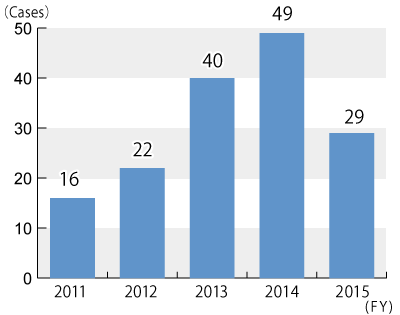
The number of cases was: 16 in FY2011, 22 in FY2012, 40 in FY2013, 49 in FY2014, and 29 in FY2015.
There were more female inquirers than male inquirers. In the age group 60s-80s, female inquirers accounted for 80% (See Diagram 2). Some inquirers were not users of incontinence underpants, but their parents, spouses or other nearby persons were using incontinence underpants.
Concerning purchase methods, more than 80% purchased through mail-order and less than 10% purchased at stores. Some purchased a set of several pairs.
There were many inquiries and complaints about bad quality (e.g. "Urine leaked out although the urination amount was less than the amount indicated ", "Absorption/texture is bad") and about size mismatch (e.g. "The seller does not accept product return although the size does not fit me").
Diagram 2: Categorization of inquirers (the first and second graphs) and purchasing methods (the third graph) (n=156)
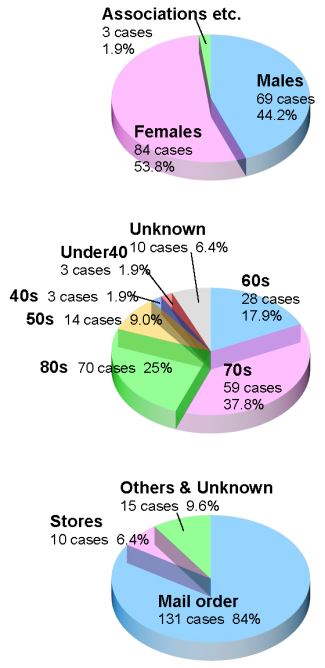
When categorized by gender, the number of male inquirers was 69 (44.2%) and the number of female inquirers was 94 (53.8%).When categorized by age group, the number was 3 in the age group under 40 (1.9%), 3 in 40s (1.9%), 14 in 50s (9%), 28 in 60s (17.9%), 59 in 70s (37.8%), 39 in 80s (25%), and 10 in the group of unknown (6.4%). When categorized by purchasing method, 131 (84%) purchased by mail order, 10 (6.4%) purchased at stores, and 15 (9.6%) were others and unknown.
- * Each ratio is rounded to one decimal place, so the total might not be 100%.
- [Case1]
- I bought incontinence underpants indicated "for 60cc" through catalog sales. When I used it, urine seeped out unexpectedly.
- (woman in her 70s in Aichi-ken / received in Nov. 2015)
- [Case2]
- I purchased a pack of 5-pair incontinence underpants advertised on a newspaper insert indicated as "possible to absorb 15-20cc". When I used one of them, urine penetrated through as far as pants liner, although I did not think the urination amount was so much.
- (woman in her 70s in Hiroshima-ken / received in Feb. 2015)
- [Case3]
- I bought incontinence underpants through mail order, but the actual size is far smaller than the size indicated. The seller told they would not accept product return, so I am dissatisfied.
- (man in his 70s in Chiba-ken / received in Oct. 2015)
Brands subject to the test
(1) Structure of incontinence underpants
A general incontinence underpants has a laminated absorber attached inside the crotch portion, although it looks like normal underpants (see Diagrams 3 and 4).
Diagram 3: Position of a laminated absorber

There are roughly three types of incontinence underpants in the market: trunks type, briefs or boxer type, and shorts type, each crotch position of which has a laminated absorber inside.
- * The above is an oblique perspective figure of the three-dimensional structure. The position of laminated absorber is highlighted in blue.
Diagram 4: Visualization of a laminated absorber
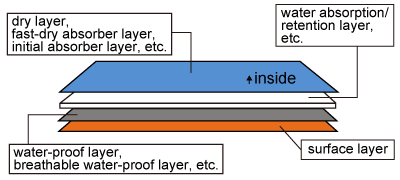
- * Some products have several layers named water absorption layer, water retention layer, or the like.
(2) Choice of brands subject to the test
Brands subject to the test were chosen in October 2015. We searched websites for incontinence underpants brands with combination of three words ("incontinence" or "leakage of urine" / "underpants" or "underwear" / "women" or "men") on major internet shopping sites (Rakuten, Amazon.co.jp, Yahoo!shopping). Among the upper listed sites as well as drugstores and mass retailers in Tokyo-to and Kanagawa-ken, we chose 5 brands for men and 7 brands for women (12 brands in total) which have an absorber inside and indicate "for light incontinence" or "for light leakage" as well as the absorption amount 50ml or less if any (See the Table 1). In addition, we used 2 brands of disposable pads advertised as to absorb light leakage by water-absorbable polymer (one for men and one for women; hereinafter called "pads") and one brand of unisex underpants-type disposable paper diapers (hereinafter called "underpants-type disposable paper diapers"). Products labeled as medium size were used for the test.
| No | for | Brand name | Company in charge of labeling | Japan Corporate Number | Purchase price (tax incl. / Yen) 8 |
|---|---|---|---|---|---|
| 1 | men | Smart boxer pantsu | Esu World | 4120001104461 | 990 |
| 2 | Kyusui pantsu | Katakura Industries Co., Ltd. | 9010001034764 | 1,070 | |
| 3 | Secret trunks 30 / 5-pair pack 9, 10 | Sinkou tu-han | 2010001018286 | 734 | |
| 4 | Sawayaka boxer pantsu | Moca trading co., ltd. | 8120001116362 | 1,238 | |
| 5 | Kaiteki boxer pantsu DX | Riso Hanbai Co., Ltd. | 3120001098390 | 1,008 | |
| 6 | women | Crabyon shikkin pantsu joseiyo | Itumi | 5150001009847 | 1,933 |
| 7 | Kyusui pantsu | Katakura Industries Co., Ltd. | 9010001034764 | 1,015 | |
| 8 | Secret shorts 30 / 5-pair pack 9,11 | Sinkou tu-han | 2010001018286 | 734 | |
| 9 | Ladies' shorts / 3-pair pack | Taimu Koubou | 8380001009160 | 699 | |
| 10 | Anshin shorts (2-pair pack) (Cotton 100%)9 | Dinos Cecile Co., Ltd. | 9011201004664 | 1,345 | |
| 11 | Rittai fit anshin shorts (N) | Dream Inc. | 4180001047829 | 1,365 | |
| 12 | Anshin pantsu sawayaka kyusyu type | PIP CO., LTD. | 1120001087841 | 1,400 | |
| reference | men | Pads for light incontinence | |||
| women | Pads for light incontinence | ||||
| unisex | Underpants-type disposable paper diapers | ||||
- *(as of Nov. 2015)
- 8 In case of a pack of several pairs, a unit price is shown as the purchase price (rounded off to the closest whole number).
- 9 Since the brand name was not indicated on the package, we referred to from description on the website.
- 10 The brand name as of April 2016 was "Secret trunks light / 5-pair set".
- 11 The brand name as of April 2016 was "Secret shorts light / 5-pair set".
- * Products No.1, 4 and 5 are boxer type. No.2 is brief type. No.3 is trunks type. All the products for women are shorts type. (See Diagram 3)
- * This test result is only related to the products purchased for the test.
(3) Indication of the absorption amount
As a result of checking websites where descriptions of the above brands are shown by companies in charge of labeling (hereinafter called "websites of companies in charge of labeling"), packages and descriptions attached, we found out that 9 brands (No.1, 2, 4, 6, 7, 9-12) out of 12 indicated the specific absorption amount one way or the other (See Table 2).
Three brands (No. 6, 9 and 10) indicated the absorption amount on the websites of companies in charge of labeling, but did not indicate it on packages and descriptions attached.
In the following test report, the absorption amount 12 is written if there was any description which appears to be the absorption amount on the website, package or description attached, while it is not written if there was no description anywhere. As for reference products, the absorption amount was referred to from the package.
- 12 In case of range specification, the minimum amount was written as the absorption amount. In case of maximum specification (e.g. up to 50cc), the maximum amount was written as the absorption amount.
| No. | Descriptions about the absorption amount | Absorption amount | |
|---|---|---|---|
| Product package, descriptions attached, etc. | Websites of companies in charge of labeling | ||
| 1 | Well absorbed up to 50cc | - | 50ml |
| 2 | Roughly 20cc | - | 20ml |
| 3 | Not indicated | Not indicated | Not indicated |
| 4 | Absorption amount: about 50cc | Absorption amount: about 50cc | 50ml |
| 5 | Not indicated | Not indicated | Not indicated |
| 6 | Not indicated | Absorption amount: roughly 30-50cc | 30ml |
| 7 | Roughly 20cc | - | 20ml |
| 8 | Not indicated | Not indicated | Not indicated |
| 9 | Not indicated | Absorption amount: roughly 50cc | 50ml |
| 10 | Not indicated | Relief absorption amount:roughly 30-50cc | 30ml |
| 11 | Absorption amount: about 40cc | Absorption amount: about 40cc | 40ml |
| 12 | Absorption amount: about 15cc | Absorption amount: about 15cc | 15ml |
- - : Advertisement was not found on the website.
- Not indicated : The absorption amount or the like was not indicated.
- * "cc" = "ml"
- * Indication of "amount of water absorption" is also written as the absorption amount.
- * As for reference products, the absorption amount was referred to from the package (men's pads and women's pads : 20ml / underpants-type disposable paper diapers: 300ml (150ml per one time) )
Test result
(1) Model test
Various actions are assumed in daily life when wearing incontinence underpants (e.g. standing up, sitting, walking, sleeping). Among those actions, the status of standing still and the status of sitting still were subject to the simulation test. The lower part of human body model wearing each brand product was moistened with 5ml artificial urine at the area of urination and observed for 5 minutes, which was repeatedly conducted to check if urine would seep out to the surface of each pair of underpants. As for the underpants-type disposable paper diapers (reference products), the indicated amount 150ml was moistened per one time. Five pairs of underpants per brand were subject to the test.
- 13 Referring to the proportions of chemical constituents of urine on the "Reference value handbook" (written and edited by Noriyuki Tatsumi, issued by Nankodo), 21g urea was dissolved in 1L of 0.9% saline to make the artificial urine for the test. Incidentally, a slight amount of food coloring agent (blue) was used to color the liquid for better visibility.
1) When new products are used in the status of standing still
As for the 9 brands with indication of the absorption amount, there was no brand that all the 5 pairs moistened with urine of the amount indicated did not generate seepage outside. As for 3 brands among them, some of the 5 pairs moistened with urine of the amount indicated did not generate seepage outside.
When a pair of normal underpants (cotton 100%) is worn by the lower part of the standing human body model and moistened with 5ml artificial urine, the liquid leaked outside in a short time (see Photo 1). As a result of testing new products of individual brands, there was no brand that all the 5 pairs moistened with urine of the amount indicated did not generate seepage outside. Some of the 5 pairs of 3 brand products (No.2, 7 and 10) moistened with urine of the amount indicated or more did not generate seepage outside (see Diagram 5). As for the brand No.9, all the 5 pairs moistened with urine of the indicated minimum amount 5ml generated seepage outside. As for the 3 brands without indication of the absorption amount (No. 3, 5 and 8), seepage occurred when urine of the amount 10-35ml was applied.
Seepage mostly occurred at the front seam in case of men's products and at the seam of crotch/hip portions in case of women's products (see Photo 2).
Incidentally, the reference products such as pads and underpants-type disposable paper diapers moistened with urine of the amount indicated or less did not generate seepage outside.
Photo 1: Seepage from normal underpants (for women)

The liquid leaked outside from the crotch portion immediately. After a few seconds, the area of seepage widely spread.
Diagram 5: Test result in the status of sitting still (new products)
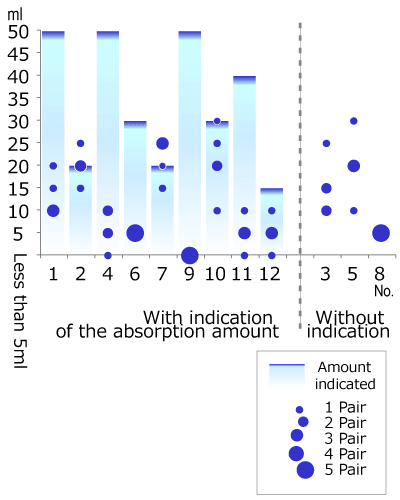
- * Plotted at the maximum value which did not generate seepage.
Photo 2: Sample visualization of seepage (new products)
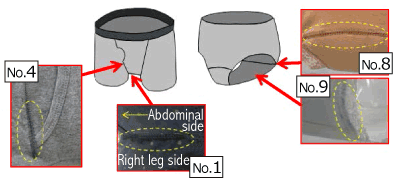
Seepage occurred at the front seam in case of men's products and at the seam of crotch/hip portions in case of women's products.
2) When using washed products in the status of standing still
Repeatedly washed products were prone to seepage even with a smaller amount of urine compared to new products
A case with products washed once and a case with products washed ten times further were examined after the test 1).
In the case with products washed once, most brand products generated seepage outside with a smaller or similar amount of urine compared to the amount in the case with new products.
In the case with products washed 11 times repeatedly, most of the brand products generated seepage outside when applying a smaller amount of urine than in the case with new products (see Diagram 6). As for four brands No. 6, 8, 9 and 11, all the 5 pairs moistened with urine of the indicated minimum amount 5ml generated seepage outside. As for No.10, there was much individual difference: some pairs scarcely generated seepage, while the others did not absorb urine and leaked it.
Diagram 6: Test result in the status of sitting still (after washing 11 times)
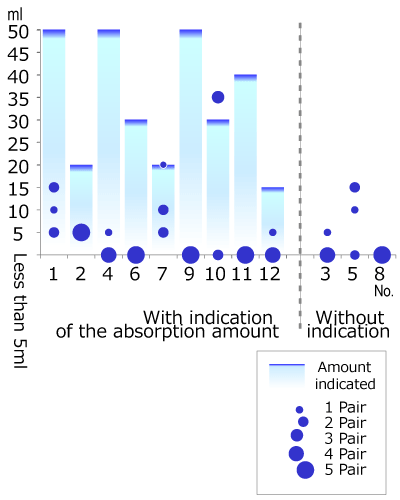
The absorption amount was less than that in the case of new products.
- * Plotted at the maximum value which did not generate seepage.
3) When using products in the status of sitting still
Among the 6 brands subject to the test in the status of sitting still, the entire 3 brands with indication of the absorption amount generated seepage outside when applying urine less than the amount indicated. They were prone to seepage with a smaller amount of urine than in the status of standing still. Among 3 brands without indication of the absorption amount, 2 brands were prone to seepage with a smaller amount of urine than in the status of standing still.
Three brands having some pairs which did not generate seepage outside with urine of the amount indicated or more under the test 1) (No.2, 7, 10) and 3 brands without indication of the absorption amount (No.3, 5, 8) were worn by the lower part of the sitting human body model and tested in the conditions of new products, products washed once, and products washed 11 times in total.
New products of 3 brands with indication of the absorption amount (No.2, 7, 10) were prone to seepage with a smaller amount of urine than in the status of sitting still: all the 5 pairs moistened with urine less than the amount indicated generated seepage outside (see Diagram 7 and Photo 3). Among three brands without indication of the absorption amount, two brands (No.3 and 8) were prone to seepage with a smaller amount of urine than in the status of sitting still.
Those washed once and washed 11 times in total were prone to seepage with a smaller amount of urine than in the case of new products.
Incidentally, the reference products such as pads and underpants-type disposable paper diapers moistened with urine of the amount indicated or less did not generate seepage outside.
Diagram 7: Test result in the status of sitting still
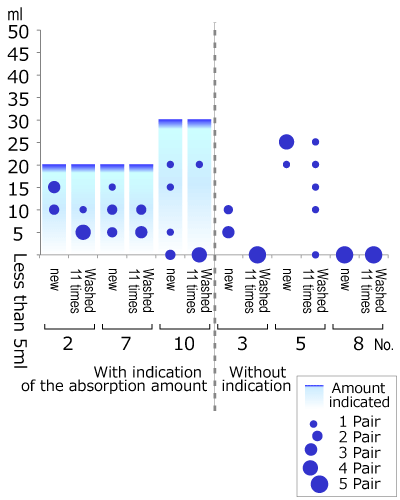
Both in the case of new products and in the case of products washed 11 times, seepage occurred with less amount than in the status of standing still.
- * Plotted at the maximum value which did not generate seepage.
Photo 3: Visualization of seepage (new products)
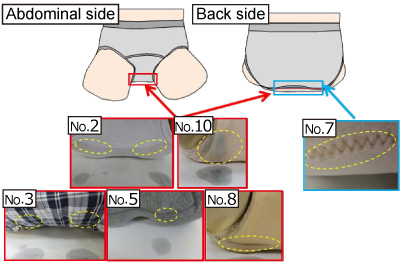
(2) Indication, advertisement
1) Descriptions about the level of leakage and types of symptoms
We checked indications about the targeted users' level of leakage and types of symptoms on the products, packages, descriptions attached, websites of the companies in charge of labeling, and the internet shopping sites.
Eight brands among 12 indicated on the products the level of leakage and types/characteristics of symptoms
Among 12 brands, 7 brands (No.2, 4-7, 11 and 12) indicated on the products that they were for users having light incontinence symptoms (e.g. "for light incontinence", "for light leakage"). Four brands (No.1, 4, 5 and 12) indicated types/characteristics of incontinence symptoms (e.g. "for light leakage when coughing, sneezing, etc.", "for those who cannot make it to a toilet in time"). Eight brands (No.1, 2, 4-7, 11 and 12) indicated in either of the above two ways.
Nine brands had advertisements on websites of the companies in charge of labeling. Among them, 8 brands indicated that they are for light incontinence
We checked if there is any advertisement or description of individual brand products on the websites of the companies in charge of labeling and found out that 9 brands (No.3-6, 8-12) out of 10 excluding 2 brands bought at stores (No.2 and 7) had advertisements or descriptions. Among them, 8 brands excluding No.5 indicated that they were for light incontinence. Two brands (No.4 and 9) indicated types/characteristics of incontinence symptoms.
In addition, we checked 6 brands (No.1, 4-6, 11 and 12) which we confirmed they were sold on shopping sites other than those of companies in charge of labeling and found out that all the 6 brands had descriptions of the level of leakage (e.g. "light incontinence", "light leakage"). Among them, one brand (No.5) did not have such descriptions on the website of the companies in charge of labeling or on packages.
2) Indication of fabric composition
Some brands had difference in indication between labels sewn on the products and packages. Concerning another brand, it was hard to understand which part corresponds to the indication of fabric composition
In accordance with the Household Goods Quality Labeling Act, underwear including incontinence underpants is required to have an easy-to-see label at a position easy to see indicating names of composed fibers of the outer fabric and the mixture ratio of each composed fiber. Indication of other parts is voluntary.
As a result of survey, one brand (No.4) out of 12 had difference in indication between labels sewn on the products and packages (see Diagrams 8 and 9). Concerning another brand (No.9), it was hard to understand which part of the fabric corresponds to the indication of composition from expressions "pad", "outer fabric", "intermediate material", and "reverse side".
Although incitation of these parts is voluntary, it is desirable to indicate in a way not to confuse consumers.
Diagram 8: Indication on labels sewn on the products (No.4 and 9)
No.4
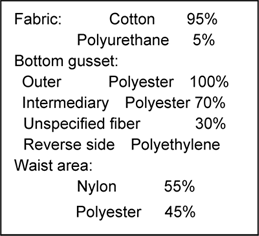
No.9
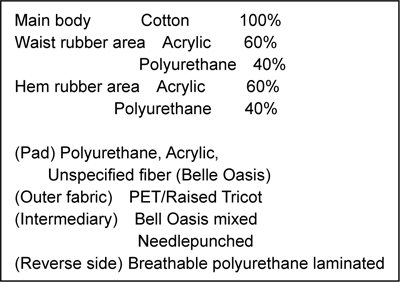
The label of No.9 indicates portions as pad, outer fabric, intermediary, and reverse side. It is hard to understand which part corresponds to these portions.
Diagram 9: Indication on the product package (No.4)

The label on the package of No.4 indicates names of fibers used for outer fabric, absorbent fabric, and breathable film. The descriptions are different from that of the label sewn on the product.
- * The underlined portions show descriptions different from those on the label sewn on the product.
- * English translation of descriptions
Questionnaire survey among companies in charge of labeling, etc.
NCAC conducted a questionnaire survey about target users' level of incontinence and actions assumed, verification methods of the absorption amount indicated, etc. concerning brand products subject to the test among 10 companies whose contact details were written on labels sewn on the products, packages or descriptions attached. NCAC received replies from all the companies.
(1) Users' level of incontinence
The extent of absorption assumed by the companies was mostly "several times of light leakage" or expressed as "total amount of several times of light leakage".
(2) Actions when using the product and time length of each action
There was variation depending on brands in actions and time length of each action which they supposed would not generate leakage. About half of the companies replied that users should change underpants/clothes as soon as possible after leakage outside.
(3) Verification methods
Verification methods for the absorption amount indicated were varied including a test of fabric using for absorber, a test of the product itself, a monitoring test, etc.
(4) Key points in buying products
They replied that users need to check if the absorption amount and the level of incontinence indicated are suitable for them as well as if the size indicated suits them, and to beware that neither replacement nor refund is possible.
Questionnaire survey among users
NCAC conducted a questionnaire survey about symptoms of incontinence, usage conditions of incontinence underpants, etc. among 100 men and 100 women (200 persons in total) aged 40 or older who had used incontinence underpants.
(1) Reasons for using incontinence underpants
Most common reasons for using incontinence underpants were "Feeling safe in an emergency", "It looks like normal underpants" and "It can be washed and used repeatedly".
(2) Purchasers, ways of purchasing, number of pairs per purchase
More than 80% of them purchased the products by themselves. About 60% purchased at stores, about 40% purchased through mail-order, and three quarters purchased several pairs at once.
(3) Actions when using the products
It was found out that most of them took daily actions such as walking, lying and sitting when they used incontinence underpants alone.
(4) Leakage from the incontinence underpants
When using incontinence underpants alone, about 20% of them experienced seepage into clothes over underwear.
(5) Dissatisfactions
Among those having dissatisfactions, nearly 20% were dissatisfied with "seepage into clothes wearing over underwear ".
Advice for consumers
(1) Some of incontinence underpants advertised as to absorb a small amount of incontinent urine generate seepage outside when applying just a small amount of urine. You need to be careful when choosing and using incontinence underpants
Incontinent underpants which have absorber at the crotch portion and look like normal underpants are sold in the market. They can be washed and used repeatedly. It is reportedly said that the absorption amount advertised or indicated on products has been verified by the companies in charge of labeling or other companies concerned. Some of the incontinence underpants under the test, however, did not properly absorb a small amount of incontinent urine and generated seepage outside from the seams even in the status of standing still. In the status of sitting when the absorber is pressed and deformed, they were prone to seepage outside even with a smaller amount of urine.
The amount and frequency of incontinence as well as actions in daily life vary depending on users, so it cannot be necessarily said that seepage does not occur up to the amount indicated. Consumers need to ask which type/level of incontinence correspond to the products at the store when choosing products and to change underpants/clothes promptly in case of leakage outside.
(2) When buying incontinence underpants, check the size and other points. First, buy just a few pairs to check if the product fits your conditions and needs
Persons with light incontinence should confirm their symptoms including the amount/frequency of incontinence so that they can choose incontinence care products suitable for their conditions.
When buying incontinence underpants, consumers should check if the size fits them and buy just a few pairs at first so that they can try and check if the product is suitable for their needs before buying more pairs.
Persons with severe incontinence or worrying about their symptoms should see a doctor to seek medical treatment.
Requests to businesses concerned
(1) Some of the incontinence underpants under the test did not properly absorb urine far less than the absorption amount advertised, which could generate seepage into clothes over underwear. NCAC requests businesses concerned to ensure clear and easy-to-understand indication when describing types/levels of incontinence and the absorption amount (e.g. by indicating a practical amount per leakage and the acceptable number of leakage times)
Among the brand products under the test, those with indication of the absorption amount did not properly absorb urine far less than the indicated absorption amount leaked outside, which could generate seepage into clothes over underwear. Those without indication of the absorption described that they were for light incontinence, but in some cases it was hard to understand from their unclear descriptions which type of symptoms and how much leakage are acceptable.
As a result of questionnaire survey among companies in charge of labeling, it was found out that verification methods supporting the absorption amount and level of leakage indicated vary encompassing from a test of fabric for absorber to a monitoring test and that the verification methods do not necessarily correspond to the actual usage.
In April 2002, NCAC already conducted a product test of incontinence care products including incontinence underpants and requested businesses concerned to establish a standardized test method and to ensure proper indication which provides a rough idea for consumers. However, it appears that a sufficient improvement action was not taken at that time.
Therefore, NCAC requests businesses concerned to improve product indication so that consumers can choose incontinence underpants suitable for their symptoms/levels of incontinence (e.g. by indicating types/levels of incontinence, by indicating a practical amount per leakage and the acceptable number of leakage times).
(2) NCAC requests businesses concerned to ensure user friendly indication of fabric composition of parts which is voluntary as well
As a result of checking indications on labels sewn on the brand products under the test, it was found out that some brands had difference in indication between labels and packages. Concerning another brand, it was hard to understand which part of the fabric corresponds to the indication of composition.
NCAC requests businesses concerned to ensure user friendly indication, although indication of these parts is voluntary.
(3) NCAC requests businesses concerned to ensure detailed size indication so that consumers can choose and buy products which fits their bodies. Moreover, NCAC requests businesses concerned to consider selling in one's so that consumers can easily try one at first
PIO-NET received inquiries and complaints about size mismatch. NCAC requests businesses concerned to represent not only size such as S, M and L but also actual dimension of each part so that consumers can choose a proper size for them.
As a result of questionnaire survey among companies in charge of labeling of the brand products subject to the test, some brand products were sold in sets only. NCAC requests businesses concerned to consider selling in one's so that consumers can easily try one at first to check if the product is suitable for their conditions.
Requests to the government
Some incontinence underpants did not properly absorb urine far less than the absorption amount advertised, which could generate seepage into clothes over underwear. This is regarded as problematic under the Act against Unjustifiable Premiums and Misleading Representations, so NCAC requests the Consumer Affairs Agency to guide businesses concerned
Among 9 brand products which indicated the absorption amount on product packages, descriptions attached, or advertisements on websites of companies in charge of labeling, 5 brand products did not properly absorb urine of 50% or smaller amount of the absorption amount indicated, which generated seepage outside, even in the conditions of new products and standing still.
The grounds for and indication methods of the absorption amount are regarded as problematic under the Act against Unjustifiable Premiums and Misleading Representations, so NCAC requests the Consumer Affairs Agency to guide businesses concerned to ensure proper indication.
